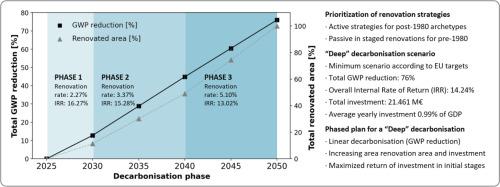Decarbonisation of the Basque Country residential stock by a holistic enviro-economic assessment of renovation strategies under the life cycle thinking for climate risk mitigation
IF 10.5
1区 工程技术
Q1 CONSTRUCTION & BUILDING TECHNOLOGY
引用次数: 0
Abstract
The present study introduces a novel methodological decarbonisation evaluation for the Basque Country (northern Spain) residential building stock with a bottom-up approach. The investigation relies on the need to develop detailed roadmaps towards decarbonising the residential stock, as demanded by the European Union (EU). Besides, the residential stock decarbonisation evaluation presents several challenges, such as the effective integration of the life cycle thinking (LCT), the diversity of building typologies, the performance gap caused by occupant behaviour and economic uncertainty. The research is based on evaluating renovation strategies in multiple residential scenarios by a complete level buildings performance simulation (BPS) and the enviro-economic evaluation with LCT. For that, we employ the tool PARARENOVATE-LCT. As a result, the bottom-up approach identifies optimal renovation scenarios for each building typology. Secondly, we set different decarbonisation scenarios, where most archetypes require active renovation strategies to reach a deep decarbonisation degree. Thirdly, we develop phased decarbonisation plans by prioritizing archetypes with the highest decarbonisation potential. This way, the plans allow a linear reduction of global warming potential (GWP) with a limited renovation rate and investment in the first stages with an increasing trend, enabling the adaptation of industry and administration.

根据减轻气候风险的生命周期思维,通过对翻新战略进行整体环境经济评估,实现巴斯克地区住宅的去碳化
本研究采用自下而上的方法,对巴斯克地区(西班牙北部)的住宅建筑群进行脱碳评估。根据欧盟(EU)的要求,需要制定详细的住宅建筑群去碳化路线图,因此进行了这项调查。此外,住宅建筑去碳化评估还面临着一些挑战,如生命周期思维(LCT)的有效整合、建筑类型的多样性、居住者行为造成的性能差距以及经济不确定性。这项研究的基础是通过完整的建筑物性能模拟(BPS)和使用生命周期思维(LCT)进行的环境经济评估,对多种住宅场景下的改造策略进行评估。为此,我们使用了 PARARENOVATE-LCT 工具。因此,自下而上的方法为每种建筑类型确定了最佳改造方案。其次,我们设定了不同的去碳化方案,其中大多数原型需要积极的翻新策略才能达到深度去碳化的程度。第三,我们制定了分阶段脱碳计划,优先考虑脱碳潜力最大的原型。通过这种方式,这些计划可以在有限的改造率下线性降低全球升温潜能值(GWP),并在第一阶段以增加的趋势进行投资,从而使工业和行政部门能够进行调整。
本文章由计算机程序翻译,如有差异,请以英文原文为准。
求助全文
约1分钟内获得全文
求助全文
来源期刊

Sustainable Cities and Society
Social Sciences-Geography, Planning and Development
CiteScore
22.00
自引率
13.70%
发文量
810
审稿时长
27 days
期刊介绍:
Sustainable Cities and Society (SCS) is an international journal that focuses on fundamental and applied research to promote environmentally sustainable and socially resilient cities. The journal welcomes cross-cutting, multi-disciplinary research in various areas, including:
1. Smart cities and resilient environments;
2. Alternative/clean energy sources, energy distribution, distributed energy generation, and energy demand reduction/management;
3. Monitoring and improving air quality in built environment and cities (e.g., healthy built environment and air quality management);
4. Energy efficient, low/zero carbon, and green buildings/communities;
5. Climate change mitigation and adaptation in urban environments;
6. Green infrastructure and BMPs;
7. Environmental Footprint accounting and management;
8. Urban agriculture and forestry;
9. ICT, smart grid and intelligent infrastructure;
10. Urban design/planning, regulations, legislation, certification, economics, and policy;
11. Social aspects, impacts and resiliency of cities;
12. Behavior monitoring, analysis and change within urban communities;
13. Health monitoring and improvement;
14. Nexus issues related to sustainable cities and societies;
15. Smart city governance;
16. Decision Support Systems for trade-off and uncertainty analysis for improved management of cities and society;
17. Big data, machine learning, and artificial intelligence applications and case studies;
18. Critical infrastructure protection, including security, privacy, forensics, and reliability issues of cyber-physical systems.
19. Water footprint reduction and urban water distribution, harvesting, treatment, reuse and management;
20. Waste reduction and recycling;
21. Wastewater collection, treatment and recycling;
22. Smart, clean and healthy transportation systems and infrastructure;
 求助内容:
求助内容: 应助结果提醒方式:
应助结果提醒方式:


